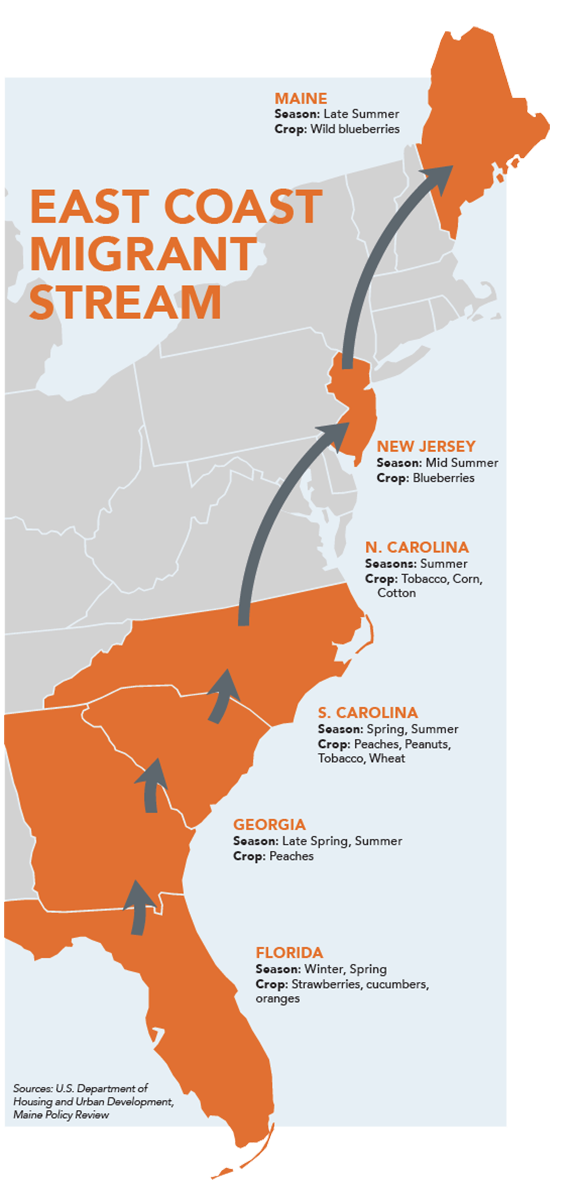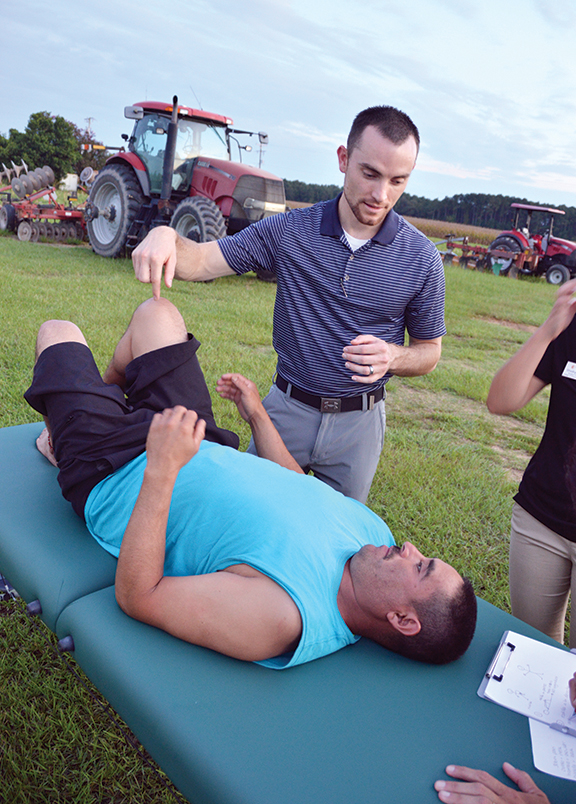North Carolina’s migrant farmworkers find medical care in mobile units manned by students from across the state (including Campbell’s DPT program)
Forty miles south of Buies Creek lies Clinton, North Carolina. Like Harnett County, its flat landscape makes it a hub of Eastern North Carolina agriculture and a home to family farms that have been passed down for generations.
Clinton is also home to hundreds of migrant farm workers who arrive each season to pick fruits, vegetables and tobacco. Working sun up to sun down, six days a week, migrant workers live isolated lives in trailers or barracks conveniently located on the land they help cultivate. Far from their families and with no respite from their 12- to 15-hour days, it’s not surprising that the men face a wide range of occupational health issues.
The labor, the heat, and the pesticides they are exposed to often lead to chronic pain on top of more serious concerns.
It’s the workers’ aches and pains that bring Campbell’s Doctor of Physical Therapy students out to the fields during growing season. As part of a joint initiative between Campbell, the University of North Carolina-Chapel Hill and the North Carolina Farmworker Health Program, student volunteers help migrant farm workers ease their musculoskeletal concerns.
 Each week, Campbell volunteers take a literal field trip to a different farm, setting up makeshift exam tables on the grass beside neat rows of crops. Their carpool caravan arrives in the evening, navigating gravel backroads and parking where their headlights will be useful after sunset, just in time for the men to get health care after their workday. Their services are vital to the farm workers, who — even if they could take time off from the fields — have little money, no transportation and a language barrier to deal with in order to find care.
Each week, Campbell volunteers take a literal field trip to a different farm, setting up makeshift exam tables on the grass beside neat rows of crops. Their carpool caravan arrives in the evening, navigating gravel backroads and parking where their headlights will be useful after sunset, just in time for the men to get health care after their workday. Their services are vital to the farm workers, who — even if they could take time off from the fields — have little money, no transportation and a language barrier to deal with in order to find care.
“It truly makes you rethink your bad day at work,” says Catherine Noonan, assistant professor of physical therapy, who has traveled with Campbell’s volunteer team for the past few seasons.
Previously unfamiliar with the parallel world of farming that surrounds Campbell, Noonan learned that migrant workers often come to North Carolina when landowners struggle to fill picking positions with domestic laborers. With H2A visas, migrant farm workers find work and American farmers find men and women willing to perform manual labor.
The workers can be paid by the piece or by the weight of how much they pick, which Noonan says often leads to refusal to follow physical therapists’ recommendations. When a right-handed man’s dominant arm gives way to injury caused by repetitive movement, the simple solution would be to switch hands. The factor of speed and efficiency in their pay makes many men decide to tough out the pain rather than use their out-of-practice left hand.
Students who didn’t grow up in rural areas might not know what to expect from a farm trip, but they can appreciate the service aspect of what they are doing — understanding what it means to practice in underserved areas where a clinic, easy access to a gym and weights and the ability to buy over-the-counter medication is not guaranteed.
Those who are from the farmlands, like Garrison Matthews, are familiar with the challenges migrant workers face. A third-year student in the middle of his physical therapy residency, Matthews grew up on a tobacco farm that hired H2A workers annually. His training and familiarity with different crop picking roles and actions gave him an advantage when it came to diagnosing musculoskeletal injuries.
According to Matthews, tobacco is probably the worst crop there is in terms of repetitive injuries because of the picking process. But physical therapists may start to see patterns of injury depending on the type of crop — for example, the constant crouching from crops like sweet potatoes leads to different back pain than nonstop stooping for strawberries.
“It was always interesting to me to see how living conditions for the workers changed from farm to farm,” says Matthews. “Every once in a while, we’d come across some pretty rough situations. Most were good, but it’s obviously not an easy life. We were doing our best with the resources we had out there, and so were they.”
Matthews took the lead on the 12 or so trips the Campbell volunteers took to farms last year. This season, a new group of students are dedicating evenings to some unorthodox hands-on training.
___________________________________________
In Clinton, the sight of a mobile health care team in such a rural spot so late in the evening is surreal. Students in crisp Campbell scrubs wait for their patients between the one-room barracks and a huge row-crop tractor. They occasionally slap at mosquitoes, but are mostly occupied with last-minute basic Spanish review before meeting their patients.
The song “Head, Shoulders, Knees and Toes” can be heard in Spanish, but they have also composed a list of other phrases they know will be necessary — the words for “shoulder blade,” “stretch” and “tell me if this hurts.”
Three of the five students are first-years and first-time volunteers, standing by while the workers take turns at UNC’s tent, expressing some nervousness at their lack of diagnostic experience paired with the language barrier.

“I’ve had a little practice in the Campbell pro-bono clinic, but the clinic is structured, with professors and more advanced students leading the way,” says first-year student Taylor Cothran. “Here, we’re just going to be thrown into the fire, and I do not have a PT vocabulary in Spanish, which could be awkward. But I feel like once I jump into it, it’ll be a great experience. ”
Before making their way to where the Campbell PT students are waiting, the migrant workers file into a mobile unit to meet a team of UNC faculty and med students for a checkup. These volunteers address issues such as diabetes, hypertension, skin complaints and eye irritation from sun and dirt. They also give tips on diet and preventative cancer screenings.
Anyone found to have serious health concerns is referred to Benson Area Medical Center, which also provides after-hours care during the growing season.
After their check up, those with musculoskeletal complaints are free to visit Campbell’s improvised station to describe their pain, hoping the students can help.
“Everything we know about these cases we get through our conversations,” says Matthews. “We can’t run tests that prove our diagnosis is right like we can in the clinic, so it’s really all about good observation skills and trust.”
One student’s Spanish helps the team identify the first patient’s complaint — pain in his lower back. She and volunteer Michelle Green, a professor of physical therapy, go to work testing his range of motion and prescribing a simple stretching regimen in broken Spanish.
The challenge for physical therapy volunteers is recommending a treatment that is feasible for the men in such a unique situation. Aside from the fact the workers won’t be visiting any office for a follow-up, Green says that financial and cultural factors force the volunteers to keep their recommendations simple.
“Some of the actions that we think would be ideal to relieve their symptoms, like buying a new pair of orthotic shoes, these workers can’t do,” says Green. “Even if we gave them name-brand shoes, they probably aren’t going to change their shoewear because of the cultural norms in the barracks.”
As the only volunteer professor on this particular night, Green coaches the first-year students to assess patients’ posture while she and a third-year student take the lead performing tests. By 9 p.m., they’ve treated four men for back and shoulder issues and one for a sore knee. If they could see the men multiple times, says Green, they would work on strengthening those muscles so they support better throughout the long workday.
As it is, Green draws pictures of each prescribed stretch with short Spanish descriptions for future reference.
“This is the best kind of experience you can get as a first-year student because it is low stakes,” Green says. “I’m not grading the volunteers, and the expectation from the patients we meet is not too high. They’re truly grateful for any relief we can give them.”
Campbell volunteers are not tasked with reviewing the workers’ documentation. The no-questions-asked environment makes for more honest communication about the workers’ pain and the daily routines that might affect it. But the anonymity and lack of follow-up mean that when volunteers give their time to treating the workers, they will never see the outcome. Green says that it’s all part of learning to work with underserved communities.
“We’ve made ourselves available to people who do good work and deserve care, and that’s really all we can do.”

